|
|
1.Detection of a Planet Outside Our Solar SystemHumanity has been interested in exploring its environment since the earliest historical times. After traveling across oceans using star navigation,1 we turned our attention to getting to know the planets inside our solar system.2 They were visited at least once with robotic vehicles3 or with an orbiting satellite.4 Then, we asked ourselves whether conditions for some form of life existed on a planet outside our solar system.5 It has been reported that nearly 500 planets were discovered with indirect methods: (1) passage of a dark planet in front of a bright stellar disk;6 (2) movement of the center of gravity of a two-body system and Doppler shift;7 (3) gravitational bending of rays passing a solar system greater than due to only the star;8 (4) spectroscopy;9 and (5) astrometry, to list a few. Initial research findings include dust clouds and double stars of different sizes.10,11 When a bolometer is incorporated, the IR techniques are recognized. When the need arises for a local oscillator, millimeter terminology is preferable. The objective of this research is to expand the width of spectral region for the optimal detection of a planet outside our solar system. Furthermore, we evaluate alternative proposals for the planet observatory site. 2.Small Number of Nearby StarsThe planet detection challenges have been formulated on the basis of the radiometric, distance, and technology issues as a signal search under highly unfavorable conditions. The issues are best understood with the help of Fig. 1. We would like to find a simplest solar system defined as having one star, similar to our sun, and one planet, likewise similar or identical to our biggest planet, Jupiter. We propose to refer to potential integrants of this solar system as Estrella for the star, and Tierra for the planet, because all the nearby stars already have a name. Fig. 1Geometry for the detection of a planet outside our solar system. The Earth-based coordinate system is given as a Cartesian system (, , ), while the nearby planetary system is displaced along the optical, -axis, with the Cartesian coordinates (, , ). In this simplest geometry, the nearby solar system includes a star, that we call Estrella, and a planet, named Tierra. All the nearby stars already have an assigned name. 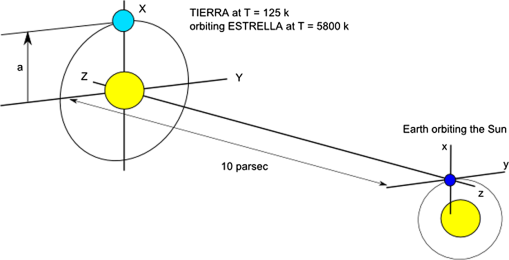 Our sun radiates as a blackbody emitter at 5800 K. The temperature of our largest and one of our most distant planets, Jupiter, is estimated at 125 K. Such a planet is considered to be easiest to detect because of its large distance from the sun. The probability that the Tierra orbits the Estrella in a plane normal to the line of sight between the Estrella and the Earth is rather small. However, at one particular moment, the Tierra will be at a projected distance from the Estrella. Its orbit may follow an elliptical path when projected on the plane normal to the line connecting the Estrella and the Earth. Tierra’s orbit around the Estrella determines its local year. It might be equal to that of Jupiter, but definitely longer than 365 Earth days. Our solar system is located in the part of the Milky Way where there are only a few sun-like stars. Figure 2 displays the number of potential Estrellas as a function of stellar magnitude, . For reference, we indicate the sun’s stellar magnitude of 4.8. We concentrate on the stars within a sphere of a certain radius with the origin at the Earth. Restricting ourselves to the sun-like stars, we find that there are only two such stars within 5 parsecs from us. Fig. 2Number of stars in the vicinity of sun as a function of stellar magnitude, with the distance from the sun as a parameter. The sun’s magnitude of 4.8 is indicated with a vertical line. The number of stars increases with the stellar magnitude and the distance from the sun. Calculated using star catalogs (Smithsonian Astrophysical Observatory, Telescope Data Center, 1991; The Yale Bright Star Catalog, 5th revised ed., Available at http://tdc-www.harvard.edu/catalogs/bsc5.html; CASU astronomical data centre, 2006; The Hipparcos, available at http://archive.ast.cam.ac.uk/hipp/hipparcos.html; NASA’s High Energy Astrophysics Science Archive Research Center, 2011; Gliese Catalog of nearby Stars, Available at http://heasarc.gsfc.nasa.gov/W3Browse/star-catalog/cns3.html; NASA’s Astrobiology Magazine, 2007; Catalog of Nearby Habitable Stars; available at http://www.nasa.gov/vision/universe/newworlds/HabStars.html). 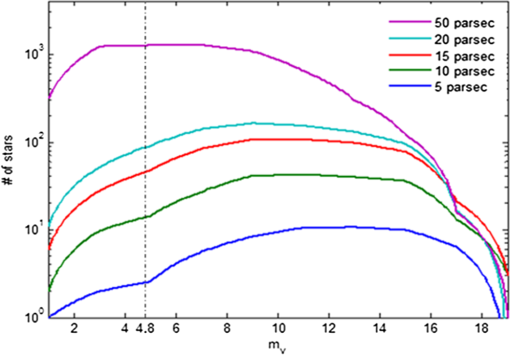 There are about 10 stars with the stellar magnitude equal to that of the sun within the distance of 10 parsecs. The number of potential Estrellas increases both with the stellar magnitude and their distance from our solar system. Stars appear like point sources both to human observers and to any optical/IR/mm instrument either constructed or under consideration at this time. We apply the principle of reversibility to the emitting and intercepting apertures in the power transfer equation to appreciate the signal collection. We postulate that the sources of radiation are planets in our solar system, and that their radiation is intercepted with an aperture at a distant Tierra. Figure 3 graphs the number of spectral photons as a function of wavelength emitted by several representative planets in our solar system intercepted by a unit aperture at a distance of 10 parsecs. Fig. 3Number of spectral photons emitted as blackbody radiators due to their surface temperature, per unit time and unit area, by several representative planets in our solar system, intercepted at a distance of 10 parsecs by a unit aperture () versus wavelength. 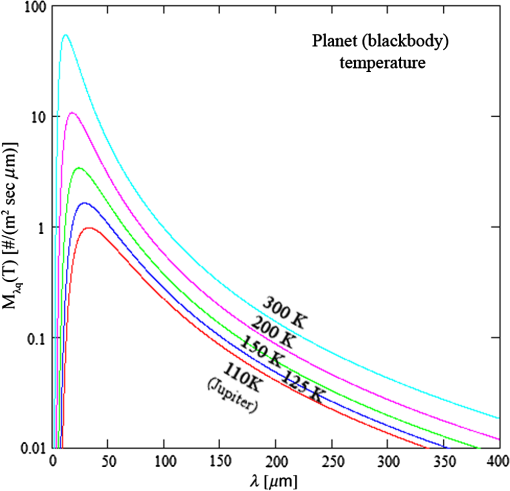 The Earth surface is modeled to emit as a blackbody radiator at the average temperature of 300 K, while the Jupiter temperature is assumed at 125 K. We observe that the intercepting aperture at the Tierra at a distance of 10 parsecs collects 1 photon at originating at Jupiter, and about 70 photons at 12 μm are emitted from the Earth. The graphs in Fig. 3 make clear the enormity of engineering and technological issues. Comparing the emission of our planets to that of our sun, we note that the planets produce much less radiation than the sun and they are also much smaller. Low planet intensity (power per unit solid angle) makes its detection challenging due to low planet signal-to noise ratio (SNR), considered next.12 3.Radiometric Signal-to-Noise ConsiderationsMost detectors, including the human eye, have a great deal of difficulty detecting a very bright and a very dim object at the same time. The limits in the dynamic range, saturation, and “bleeding” of the bright object onto the image of the dim object prevent their simultaneous detection. Figure 4 depicts the radiometric problem illustrating the darkness of the planets relative to the brightness of the sun by looking at some representative planets in our solar system. It graphs the ratio of the number of spectral photons emitted by several representative planets divided by the number of spectral photons emitted by the sun, at its peak emission, as a function of wavelength. In this analysis, two sources of radiation are considered for the planets: self emission due to the planet surface temperature and the radiation originated at the sun, intercepted by the planet and reflected from it. Fig. 4Normalized number of spectral photons emitted by the sun and several planets as a function of wavelength, the normalization factor being the maximum sun emission. The ratio of the number of planet spectral photons over the number of sun’s spectral photons may be considered simplest signal-to-noise ratio (SNR).  In this analysis, the sun and the planets are considered extended bodies; therefore, the distant and large Jupiter reflect about 10 times the amount of radiation of the Earth at 0.7 μm. Planet Neptune is also distant, but small, subtending a relatively small solid angle at the sun and reflecting nearly a hundred times less sun radiation than the Earth at the peak of the sun emission spectrum. For graphs displayed in Fig. 4, both the planet and the sun are treated as point sources. The Tierra distance equals that of Estrella, so distances cancel out. The size of the intercepting area and signal integration time are the same for both Estrella and the Tierra, as the radiation is incident on the same detector surface. The sun emission curve is normalized to 1 at its peak emission. The planet curves, therefore, are a simplest spectral radiometric SNR. The signal is defined as the quantity of interest, i.e., the number of photons originating at the planet. The radiation emitted by the Estrella is thus considered noise. Other sources of noise may be included when the instrumental concept starts to take a more definite form in the quest for the Tierra detection. The graphs display the spectral information, i.e., the number of (spectral) photons as a function of wavelength, because all the detectors have a limited detection interval. They detect all radiation incidents on the sensitive surface, independently of its origin at Estella or Tierra. We next examine some potential detection wavelength intervals. 3.1.Peak of the Estrella EmissionAt the sun peak emission in the visible, the number of sun photons reflected from the Jupiter is smaller by a factor of than the number directly emitted by the sun. This may be read directly from the vertical coordinate in Fig. 4. The SNR is nearly 10 times smaller still for the Earth, decreasing nearly to . This value arises purely from the planet diameter and the distance from the sun. Self-emission is negligible at this wavelength region (see also Fig. 3). Research groups that seek to “null” the star radiation often study this detection spectral region. 3.2.Peak of the Tierra EmissionWe find the second peak due to the planetary self-emission at the longer wavelengths. Additionally, the planet temperature determines the spectral position of the peak emission. It is shifted to the longer wavelengths because sun emission decreases with longer wavelengths. In the case of the Earth, the signal-to-noise peak for spectral photons is found to be at about 18 μm. Examining the more favorable case of Jupiter, we find the peak with spectral photon SNR of at about 35 μm. This spectral region has been studied in Ref. 5. 3.3.Highest Signal-to-Noise Ratio (Number of Tierra Photons Over the Estrella Photons)Interestingly, though, the IR peak does not represent the highest SNR. Considering that the sun emission falls off more rapidly than that of Jupiter, the photon SNR slowly increases with increasing wavelength. At 100 μm, it becomes about . The rate of the photon SNR increase with increasing wavelengths, while relatively small, is about . We concentrate on even longer wavelengths, around 300 μm, to apply this rate of increase to the photon number ratio. We calculate it to be approximately at 300 μm.13 Placing a planet detection observatory on the far surface of the moon would avoid the issues associated with atmospheric transmission and turbulence at submillimeter wavelengths. 4.Interferometric Array on MoonPreviously, we analyzed the irradiance distribution generated by a point source in infinity, and sampled by two-aperture optical system in the far plane (Fraunhoffer region), or the focal plane of an imaging system.14 We showed that the pattern consists of straight interference fringes. When there are two such emitting objects, the patterns are displaced with respect to each other.15 The modulation ratio depends on the source intensity ratio. Thus, the Estella and the Tierra generate two superimposed interference patterns. As a minimum, four samples are needed to determine four parameters of the two patterns: two amplitudes, one period, and one displacement. When the relative positions of these two sources are unknown, sampling needs to be performed over a two-dimensional plane. Thus, a number of small telescopes, of about 1-m radius, may be used to perform sampling and their separation may subtend up to 75 m, corresponding to the near-Estella candidates. This array requires the absence of atmosphere to perform well. The measured fringe separation at a given observation wavelength determines the angular separation of the Tierra from the center of the Estrella. Three potential sites to place a Tierra observatory include: on the surface of the Earth; in space orbiting the Earth or in the zero gravity point between the Earth and the moon; and on the nearest solid body, the moon. The observational strategy of placing the apertures on the far side of the moon is expected to eliminate stray light concerns to a high degree.16 Table 1 lists some of the advantages and disadvantages of these sites for the Tierra observatory. Table 1Moon-, space-, and Earth-based arrays for the Tierra detection: comparison of features.
Note: The symbols “+” indicate advantage, “−” disadvantage, “±” either, under different circumstances. For example, habitat construction is necessary for space- and moon-based observatories, but it represents a negative feature. A double symbol, such as “− −,” for the Earth atmospheric transmission indicates that this feature eliminates this choice completely. Among these, the observatory on the moon appears to have most advantages, and the smallest number of critical disadvantages. The absence of an atmosphere on the moon is probably the most important advantage when comparing Earth- and moon-based observatories for the Tierra detection. On the moon, there is no problem with the spectral absorption of the signal within the Tierra spectral exitance. In contrast, our atmosphere transmits only few wavelength intervals of the Tierra spectrum and provides an enormous amount of scattered radiation. The space-based observatory might be similar to the space station, with the telescopes docked at its sides. Appreciable difficulties arise in maintaining the multitelescope structure floating freely or orbiting in space, with precisely controlled aperture orientations for long-term observations. This situation is exacerbated when an array of apertures might have to track the same Estrella for a number of hours, without a solid or stable reference surface. It might require the rotation of the whole space station structure, with all the telescopes attached to it rigidly to track an Estrella. The implementation of such an autonomous, finely controlled, rotating structure appears to be a rather formidable task. Additionally, the platform movement and rotation might also represent a significant inconvenience to the space station crew, already dealing with the weightlessness during the performance of their duties. We favor the placement of a multiaperture telescope observatory on the far side of the moon. This site allows it to avoid seeing the Earth and its active atmosphere. From there, it can look into deep space, not seeing the sun for at least 75% of the lunar orbit, or 21 out of 28 days of the moon period around the Earth. Figure 5 lays out the proposed configuration for detecting the Tierra from the far side of moon. Two planetary systems are shown. In the yet unknown Estrella system, the Tierra orbits around its Estrella, indicated schematically in the upper left corner. In the lower right corner, the Earth rotates around the sun, and the moon circles the Earth. While the Earth rotates about its axis, giving humans a 24-h diurnal cycle, the moon always shows the same face to Earthlings. Thus, the observatory location on the far side of the moon places it in an environment of a low-radiative noise. In this figure, the sun–moon (Earth) line is shown perpendicular to the Tierra (Estrella)–moon line. In this configuration, solar radiation provides an insignificant amount of optical/radiative noise to the lunar observatory. Likewise, the observatory is protected from the stray light from Earth or any radio frequency communication flooding the near-Earth space environment. Fig. 5Lunar observatory on the far side of the moon is looking for the Tierra, except on the Earth moonless nights when the moon is located between the Earth and the sun. 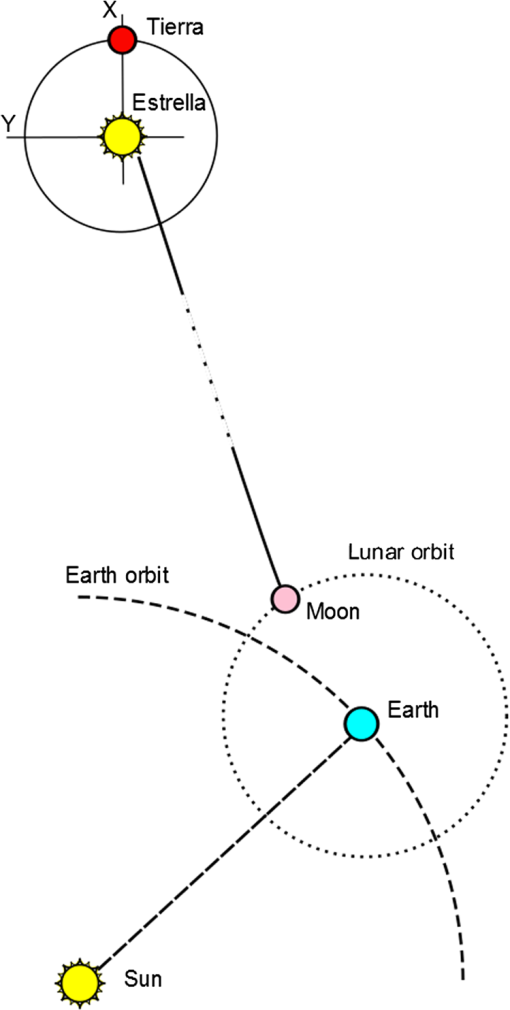 Figure 6 indicates the artist’s concept of the Tierra observatory on the far side of the moon, outlining an array of telescopes. This observatory would never be seen from the Earth, just as it never sees the Earth surface or the radiation emanating from it. The sun would see it during nearly half of the lunar rotation period. However, the only solar rays that might end inside the telescope structure are those that are diffracted and scattered at the telescope edges and inside surfaces. Employing established baffle design procedures, the effect of these rays on producing stray light may be significantly limited.16 Fig. 6Telescope array on the far side of the moon receives radiation only from the unseen planetary system when the telescopes are bore sighted on the Estrella. 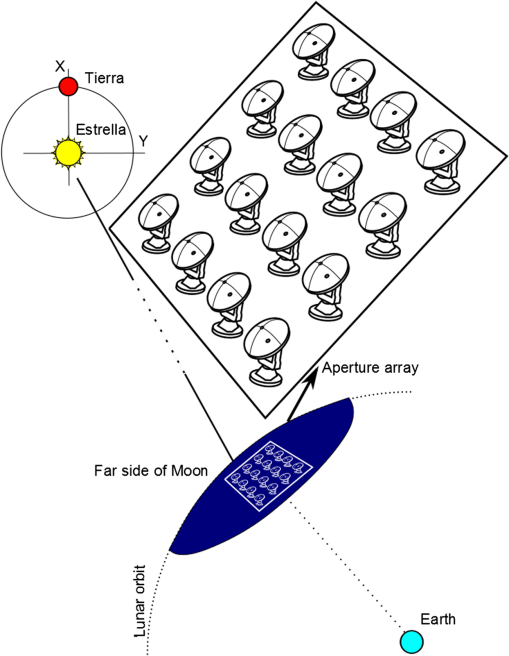 We estimate that only a quarter of lunar period is unavailable for observation in this atmosphere-free environment. On the so-called moonless nights, when the moon is located between the sun and the Earth, the observatory could be serviced and the staff would rest or be rotated from the moon assignment. The periods of partial and full sun illumination might be used to regenerate the green energy reserves. Finally, most discussions about placing an observatory on the moon end up with focusing on its surface features and history. Its surface is marred with craters because any asteroid that fell on its surface left a mark, excavating a small hole on it. A lunar observatory is actually quite similar to the space station in its susceptibility to the asteroid devastation. The International Space Station is also located in space, without the protection of a thick (Earth) atmosphere. Nevertheless, neither the debris in the orbit nor any asteroid has so far hit it catastrophically. The probability of an observatory being impacted by an asteroid while on the moon or in the space around the Earth is about the same, depending only on the cross section of the structure, as seen by the arriving asteroid. The moon surface is, indeed, covered with impact craters, but its features have been sculptured for a long, long time. Enclosing the observatory with a wall would minimize the issue of dust and small rocks. All the engineering development for the construction of a telescope array on the moon has been proven and is achievable with the current technology. Even the delivery of individual telescopes is within the current state of the art, considering many important experiments that were accomplished on the space station. The telescope travel to the moon will only be subject to the forces that the space-based observatories, such as the Hubble or the Infrared Space Observatory, undergo when they are lifted into orbit. When we hesitate about placing fine, expensive instruments on the desolated, rough, rocky moon surface, we only need to recall that more than 40 years ago, the Apollo astronauts left a high-precision aperture array of retroreflectors to measure the universal time. 5.ConclusionsWe expanded the width of spectral region to search for the optimal detection of a planet outside our solar system up to the submillimeter region. We proposed a simplest SNR as the radiation emitted by the planet in a spectral band of variable width and a central wavelength detected at the Earth over the same quantity for the star. For a solar system similar to our own, we find the SNR increases by a factor of about 100 in comparison to that considered previously. We proposed the planet detection in a spectral interval around 0.2–0.3 mm. We evaluated environment for alternative sites for the planet observatory, concluding that the moon offers an optimal site due to its atmosphere-free environment and stable, solid base. The location of the observatory on the far side of moon will allow for a lengthy nights for observation during complete absence of the sun. These periods will facilitate photon collection for as long as needed providing the undisputable evidence for the presence of a Tierra should one be invisibly orbiting a nearby Estrella. AcknowledgmentsThe CONACYT, the Mexican Science Foundation, provided partial funding to perform this work. ReferencesM. S. Scholl,
“Experimental demonstration of a star-field identification algorithm,”
Opt. Lett., 18
(6), 402
–404
(1993). OPLEDP 0146-9592 Google Scholar
G. Arnoldet al.,
“MERTIS–thermal IR imaging of mercury: advances in mid-IR remote sensing technology for planetary exploration,”
Proc. SPIE, 7808 78080I
(2010). http://dx.doi.org/10.1117/12.860144 Google Scholar
M. S. SchollS. Eberlein,
“Automated site characterization for robotic sample acquisition systems,”
Opt. Eng., 32
(4), 840
–846
(1993). http://dx.doi.org/10.1117/12.61197 OPEGAR 0091-3286 Google Scholar
M. S. Schollet al.,
“Site certification imaging sensor for mars exploration,”
Opt. Eng., 30
(5), 590
–597
(1991). http://dx.doi.org/10.1117/12.55842 OPEGAR 0091-3286 Google Scholar
M. S. Scholl,
“Signal detection by an extra-solar-system planet detected by a rotating rotationally-shearing interferometer,”
J. Opt. Soc. Am. A, 13
(7), 1584
–1592
(1996). http://dx.doi.org/10.1364/JOSAA.13.001584 JOAOD6 0740-3232 Google Scholar
T. Brownet al.,
“Hubble space telescope time-series photometry of the transiting planet of HD 209458,”
Astrophys. J., 552
(2), 699
–709
(2001). http://dx.doi.org/10.1086/apj.2001.552.issue-2 ASJOAB 0004-637X Google Scholar
R. Butleret al.,
“Ultra-high-precision velocity measurements of oscillations in alphacentauri A,”
Astrophys. J., 600
(1), L75
–L78
(2004). http://dx.doi.org/10.1086/381434 ASJOAB 0004-637X Google Scholar
A. Udalskiet al.,
“A Jovian mass planet in microlensing event OGLE-2005-BLG-071,”
Astrophys. J., 628
(2), L109
–L112
(2005). http://dx.doi.org/10.1086/432795 ASJOAB 0004-637X Google Scholar
L. Richardson,
“A spectrum of an extrasolar planet,”
Nature, 445
(7130), 892
–895
(2007). http://dx.doi.org/10.1038/nature05636 NATUAS 0028-0836 Google Scholar
C. Moutouet al.,
“The HARPS search for southern extra-solar planets XXVII. Seven new planetary systems,”
Astron. Astrophys., 527
(2), A63
(2011). ASJOAB 0004-637X Google Scholar
J. Wrightet al.,
“Ten new and updated multiplanet systems and survey of exoplanetary systems,”
Astrophys. J., 693
(2), 1084
–1089
(2009). http://dx.doi.org/10.1088/0004-637X/693/2/1084 ASJOAB 0004-637X Google Scholar
M. StrojnikG. Paez,
“Radiometry,”
Handbook of Optical Engineering, 649
–700 Marcel Dekker Inc., New York, NY
(2001). Google Scholar
M. StrojnikG. Paez,
“Interferometry to detect planets outside our solar system,”
Interferometry Applications in Topography and Astronomy, 195
–220 InTech Pub. Co., Rijeka, Croatia
(2012). Google Scholar
C. Vasquez-JaccaudM. StrojnikG. Paez,
“Effects of a star as an extended body in extra-solar planet search,”
J. Mod. Opt., 57
(18, 20), 1808
–1814
(2010). http://dx.doi.org/10.1080/09500340.2010.528564 JMOPEW 0950-0340 Google Scholar
M. StrojnikG. PaezM. Mantravadi,
“Lateral shearing interferometry,”
Optical Shop Testing, 649
–700 Marcel Dekker Inc., New York, NY
(2007). Google Scholar
M. S. Scholl,
“Stray light issues for background-limited far-infrared telescope operation,”
Opt. Eng., 33
(3), 681
–684
(1994). http://dx.doi.org/10.1117/12.163401 OPEGAR 0091-3286 Google Scholar
BiographyMarija Strojnik received her MS degrees in physics, optical sciences, and engineering, and her PhD degree in optical sciences. NASA awarded her six Technology Development Certificates. She conceptualized, designed, and demonstrated an autonomous, star-pattern-based navigation technique, employing an intelligent camera, in a blind experiment. This discovery is described in the popular “Through the Wormhole” TV program. SPIE conferred upon her the George W. Goddard award. She is a fellow of the OSA and SPIE. Michelle K. Scholl, SPIE student member, earned a BS degree in psychology, specializing in cognitive sciences, in 2011, and a BS in molecular bioscience and biotechnology in 2012. She is interested in molecular processes conducive to life formation and neurological evolution on this and other worlds. Her long-range concern is the temporal delay between technological developments and establishment of international laws guiding their ethical deployment. |

